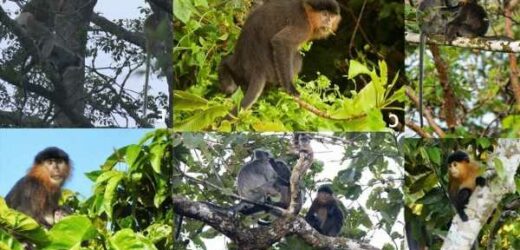COP26: Fleming says deforestation will get worse before it improves
We use your sign-up to provide content in ways you’ve consented to and to improve our understanding of you. This may include adverts from us and 3rd parties based on our understanding. You can unsubscribe at any time. More info
Scientists believe that the mystery species is a mixture of a proboscis monkey that mated with a distantly related silver langur when it was unable to reach females of its own species. The female monkey was first spotted in 2017, after photographs of the creature along the Kinabatangan River in Sabah, Malaysia, were shared on social media wildlife photography groups.
After studying the photographs, the researchers concluded that based on features like its colouring and proportions, the mystery monkey was likely the offspring of a male proboscis monkey (Nasalis larvatus) and a female silver langur (Trachypithecus cristatus).
They found that the monkey’s face looked closer to that of a proboscis monkey, although its nose, while having some pronounced features, was not as long.
The creature’s dense, grey hair resembled that of a silver langur, although it did not have the species’ distinctive side mane, while the mane’s colour had patterns that were typical of proboscis monkey.
The researchers noted that according to observers in the region, mixed-species groups were common, with cases of inter-species mating also being spotted.


The scientists believe that these creatures may have emerged as a result of habitat loss and fragmentation of the region.
Forest in Malaysia are under threat as plantations for palm oil have expanded, pushing the two parent species to a much smaller region along the Kinabatangan.
Nadine Ruppert, a primatologist and senior lecturer at Universiti Sains Malaysia, who co-authored a recent study of the animal, which was published in the International Journal of Primatology in April, noted such interspecies interactions typically occur when both parent species are confined in a small space.
However, she added that further research was required to examine the home range of both parent species.

She told the Guardian: “It’s hard to assess if the groups are ‘trapped’ within this small fragmented habitat patch that is surrounded by river, oil palm [plantations] and settlements [and] roads, or if they can disperse further upriver to the close-by intact forest.
“Habitat loss and fragmentation, in general, is always a threat to wildlife populations and should always be mitigated or avoided.”
According to a previous study, the region has faced dramatic reduce
ions in forest cover in the area over recent decades, about 39.5 percent of its cover between 1973 and 2010.
According to Prof Ruppert, if the loss of habitat is the reason for these hybrid species, it suggests that adult proboscis males have had difficulty finding mating partners of their own species.
DON’T MISS:
Russia threatens ‘major’ outbreak of fatal disease [REPORT]
Three Russian military planes violate Swedish airspace [REVEAL]
‘Back into our hands!’ Renewed calls to NATIONALISE energy to solve… [SPOTLIGHT]

As a result, these males have been taking over silver langur harems, she noted.
She added: “Then probably one species might become locally displaced in these patches of low habitat quality, as it will be outcompeted by the more dominant species.”
Source: Read Full Article


